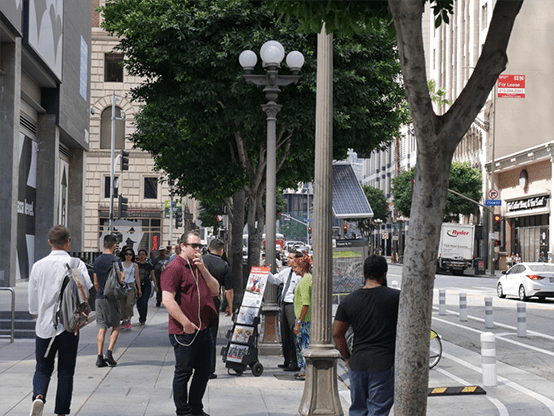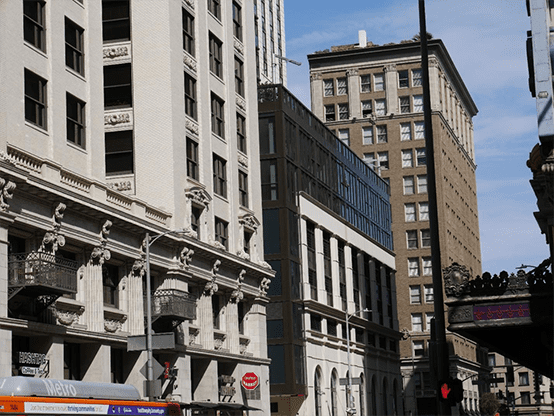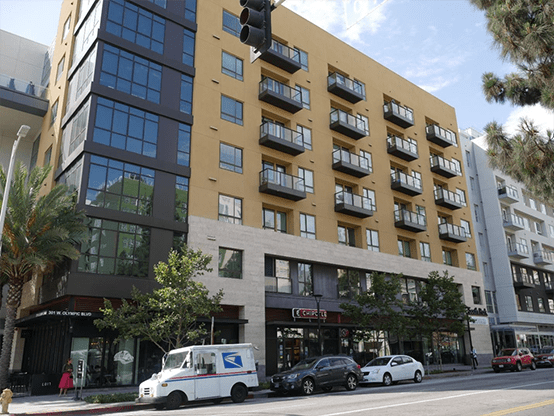Downtown Los Angeles Is Coming Home—to the New Elite

In The Death and Life of Great American Cities, Jane Jacobs wrote derisively about the state of Downtown Los Angeles in 1961:
So spattered and decentralized are the central functions … that the only element of its downtown that has full metropolitan dimensions and intensity is that of the leisured indigent…. Los Angeles is fortunate that the vacuum of a disintegrated downtown has not been appropriated by predators but has been relatively respectably populated by a flourishing Skid Row
Fifty-eight years later, Downtown Los Angeles has evolved. No longer is it the sole domain of the homeless (although LA’s Skid Row remains the highest concentration of poverty anywhere in the United States). Instead, it’s a collection of tech bros, young professionals, bar hoppers, druggies, tourists disappointed by Hollywood, unhappy anti-gentrification activists, foodies, Taco Trucks, wannabe artists, real estate speculators, small businessmen, street cleaners, street vomit, a wonderful bookstore, and some of the most interesting new areas of Los Angeles.
The dominance of coastal cities has long been portrayed in the media as growing economic inequality between Blue and Red America. But these cursory explanations miss the growing economic inequality within coastal cities. As real estate values have exploded in West LA neighborhoods like Venice, Santa Monica, and Brentwood, the protectionist phenomenon known NIMBYism (Not In My Backyard) has spiked as well. In Venice Beach, one of the most liberal areas of America, residents booed Los Angeles Mayor Eric Garcetti when he announced the building of more homeless shelters.
With the incredible difficulty of building in suburban neighborhoods in Los Angeles, developers looking to cash in on the rising cost of rent have turned their eyes on the only area completely abandoned by pesky community organizers: Downtown. Until a decade or so ago, the only people living Downtown were homeless, and developers benefit when homeless have few rights.
Walking down Broadway Street (whose name seems envious of New York’s Broadway, because nothing in Los Angeles is authentic), it seems strange to imagine that the area was once abandoned. The streets are diverse and walkable. Most of the Historic Core is still very beautiful. Neoclassical architecture sits side by side with Art Deco and Postmodern buildings. It’s a snapshot of LA history that can’t be found in the sprawling strip malls and palm trees of the popular imagination.

Unfortunately, it’s those same postwar strip malls that led to the eventual degradation of Downtown. In the early 20th century, the heyday of Downtown LA was born before the age of the car. Back then, Downtown was known only as Los Angeles, a city separate from other cities such as Pasadena or Glendale which would later be engulfed into the larger county of Los Angeles. In these early days, Los Angeles developed in the traditional style of older American cities; oil barons from the west came downtown and built beautiful monuments to their legacies. That’s when many of LA’s historic landmarks were built, from the cast-iron jungle of the Bradbury Building to the austere brick triplets of the Millennium Biltmore Hotel.
This all changed, of course, once the car arrived. Mid-century Los Angeles exploded outwards, with abundant housing subsidies from the federal government and the post-war boom combining to create what we now know as California sprawl. Much like the style of today’s Sun Belt expansion of housing, Los Angeles was the forerunner for huge highways and sprawling city life. At the time, it led to an expansion of cheap housing for the American middle-class home from World War II.
Half a century later, the limits to sprawl have been reached. Los Angeles has the worst traffic in the United States, largely as a result of sprawl and poor zoning codes that force housing away from jobs. To the west, the sea has drawn a clear stop to expansion. Further north along the coastline, cities like Malibu have been hit hard by the recent dramatic wildfires, as expansion into dangerous fire zones led to the destruction of lives, homes, and communities. Along every other side, deserts and mountain ranges block further expansion of cheap suburban land. There’s nowhere left to expand but upwards.
Unfortunately, Los Angeles has been slow to shift toward upward expansion. The good news is that LA has not lost what President George H.W. Bush described as “a thousand points of light.” There’s a strong culture of civil society, with numerous charities, community clubs, and activist groups all participating in local governance. The bad news is that these groups inevitably oppose building more housing.
It’s a strange eclectic mix of wealthy suburban owners, anti-gentrification activists, and socialists who oppose city growth. This group of anti-growth activists inevitably show up to oppose any new construction in any part of suburban Los Angeles. Suburban homeowners oppose new construction on the grounds that it affects local neighborhood character, anti-gentrification activists fear the expulsion of minority communities, and socialists rant about the evils of letting needs be dictated by capitalists.
These anti-construction groups, the so-called NIMBYs, are emblematic of a classic clash within conservatism, between Hayekian libertarianism and Burkean traditionalism. The YIMBY (Yes In My Backyard) movement advocates for housing, noting the works of pro-development economists like Professor Ed Glaeser of Harvard. The NIMBY crowd, while ostensibly all Democrats, advocates for local identity and continuity. Solving the issue of development in Los Angeles could almost be described as a conservative issue. It’s a battle between the needs of the market and the needs of the community.
So far, the solution from City Hall has simply been to avoid constructing in politically tense neighborhoods. Downtown Los Angeles, with its 9-to-5 culture and history of urban abandonment, has been brought back to life in the past two decades. City Hall has been on a tear to rebuild dilapidated streets. An Adaptive Reuse ordinance passed in 1999 that allowed developers to reuse commercially-zoned buildings as housing. These renovated apartments serve as the set for numerous Instagram photos of artist lofts with exposed brick walls and open-air lighting. The hub of Union Station serves as a possible future center of Los Angeles, although the relative unpopularity of the Light Rail lines running through the county put that future in question. The LA bikeshare system theoretically makes Downtown multimodal as well, although it’s rare to see someone actually using the rather clunky, one-size-fit-all bikes. Theoretically, it’s an urbanist paradise!
Then you have superblocks like these.

As Downtown LA has fled from its former roots as homeless capital of the nation, construction has boomed. This has led to the distinction of being one of the only regions in the city where rents have actually stayed stable, rather than the rent-controlled neighborhoods so fiercely protected by activists. This has also led to the construction of plenty of bland, corporate, cookie-cutter mixed-use developments. On street after street, these modern mixed-use superblocks share space with older, more traditional buildings. The traditional streets have a blend of buildings from different ages; in contrast, the modern superblocks have a blend of fast-food chains from Chipotle to Subway.
In some ways, these superblocks are the suburbs of our day. They serve a young populace eager to move into their own places and don’t care much about the homogenization of the street. The process of suburbanization created a quintessentially American identity that lasted for decades; the process of re-urbanization will do the same.
While architects may decry the unoriginality of the superblocks, and traditionalists may bemoan the lack of continuity with the surrounding areas, the fact remains that this area is the only place willing to build housing for the next generation. All other areas of Los Angeles remain testaments to history and the generations of the post-war boom. They stay stagnant, encased in a sort of living nostalgia.
The sad part about Downtown LA are the people who move here. The average income of the young professional who lives in Downtown is nearly $100,000. As members of Los Angeles, a city that serves as the home of the media and entertainment elite, these are the people who will define the next generation of American identity. Unlike the suburbs of the post-war generation, these aren’t middle-class families looking to reach their American Dream. These are the privileged elite of the populist imagination: young, secular, unlikely to marry early, financially secure, liberal.
Unable to move into the communities of their parents, they have moved to conquer Downtown. The next generation of this elite will make their mark on the old downtown—and soon will again become the core of the city. This all brings up one troubling question: if the last version of suburbanization is dominated by the last generation—and this generation’s is dominated by the elite—where will the ordinary Angeleno go to seek his American Dream?
Alix Ollivier lives in Los Angeles.
Comments